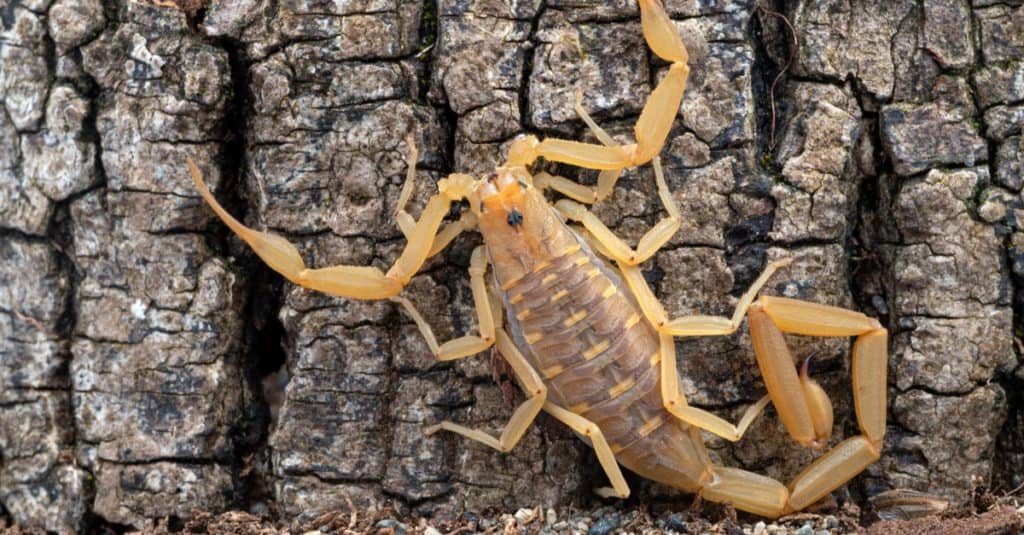Bark Scorpion
Centruroides Sculpturatus
Glow under UV light
Advertisement
Bark Scorpion Scientific Classification
- Kingdom
- Animalia
- Phylum
- Arthropoda
- Class
- Arachnida
- Order
- Scorpiones
- Family
- Buthidae
- Genus
- Centruroides
- Scientific Name
- Centruroides Sculpturatus
Read our Complete Guide to Classification of Animals.
Bark Scorpion Conservation Status
Bark Scorpion Facts
- Prey
- Insects
- Name Of Young
- Scorplings
- Group Behavior
- Sociable
- Fun Fact
- Glow under UV light
- Biggest Threat
- Predators
- Most Distinctive Feature
- Venomous stinger
- Temperament
- Mildly aggressive
- Litter Size
- 25-35
- Habitat
- Forests, grasslands, and deserts
- Diet
- Omnivore
- Lifestyle
- Nocturnal
- Location
- North America, Central America, South America
Bark Scorpion Physical Characteristics
- Color
- Brown
- Red
- Black
- Beige
- Sandy
- Blonde
- Light-Brown
- Skin Type
- Shell
- Lifespan
- 3-7 years
- Venomous
- Yes
- Aggression
- Medium
View all of the Bark Scorpion images!
Summary
Bark scorpions are among the most venomous scorpions found in the United States. While most are relatively harmless, a few species possess potent venom capable of causing serious medical complications. These tiny arachnids excel at climbing vertical surfaces and are often encountered in and around human dwellings. Although they come in a range of patterns and sizes, almost all fluoresce under UV light.
5 Bark Scorpion Facts
- Bark scorpions are nocturnal hunters and glow under UV light.
- Unlike most arachnids, bark scorpions give birth to live young, known as scorplings or nymphs.
- Bark scorpions excel at climbing rough vertical surfaces such as trees, hence their name.
- While most scorpions are solitary, bark scorpions often live together in packs containing 20 or 30 members.
- Bark scorpions have terrible eyesight and often sting when startled.
Bark Scorpion Scientific name
Most barks scorpions belong to the family Buthidae, the largest scorpion family. Within this family, several species in the genus Centruroides go by the vernacular name bark spider. Among them include the striped bark spider (Centruroides vittatus), the slender bark scorpion (C. gracilis), the Baja California bark spider (C. exilicauda), and the Arizona bark scorpion (C sculpturatus). C. sculpturatus was once included with C. exilicauda, but toxicity and DNA analysis eventually differentiated them as separate species.
The striped bark scorpion gets its name from the two dark stripes on the front of the abdomen. Similarly, the slender bark scorpion’s name derives from its relatively narrow frame and tail. Meanwhile, the Baja California bark scorpion and Arizona bark scorpion are both named for the geographic regions where they are normally found. Regardless, all bark scorpions share the same common name thanks to their shared skill in climbing vertical surfaces. You can often find them climbing trees or hiding under logs, hence the name “bark scorpion.”
Bark Scorpion Appearance

Unlike most scorpions, bark scorpions often travel in packs.
©Ernie Cooper/Shutterstock.com
Bark scorpions vary in appearance depending on the species. They range in length, although most tend to measure on the medium-to-large size. For example, C. exilicauda measures 1.5 to 3 inches long, while C. gracilis can grow up to 6 inches long. Generally, they appear quite slender and feature long, thin tails. Both C. exilicauda and C. sculpturatus appear either sandy-colored or light brown, while C. gracilis typically looks reddish-black or dark brown. Meanwhile, C. vittatus sports a noticeable pattern consisting of two dark, longitudinal stripes on the front of its abdomen. Most bark scorpions glow neon blue when exposed to ultraviolet light.
Like all arachnids, bark scorpions have eight thin legs. They possess slender, powerful tails that end in a sharp, venomous stinger. Their bodies are covered in a tough exoskeleton made of chitin, a flexible molecule composed of nitrogen and polysaccharide. Lastly, all bark scorpions have two large, grasping pedipalps (also known as pincers) which they use to grab their prey.
Bark Scorpion Behavior
Unlike most scorpions, bark scorpions often travel in packs. Although they often hunt alone, they frequently live and sleep in groups of 20 or 30. They most often exhibit this behavior during colder months, during which time they will go into hibernation. You can often find them climbing rough vertical surfaces such as trees, hence their name. That said, they prefer cool, moist areas and possess an irresistible attraction to water. They can fit their bodies into spaces no thicker than a credit card, allowing them to navigate between tight openings. Bark scorpions rarely attack animals larger than themselves but will sting when alarmed. Compared to most scorpions, which hold their tails over their bodies, bark scorpions often position their tails to the side.
Bark Scorpion Habitat
Bark scorpions live in a wide range of geographical regions, including deserts, forests, and grasslands. During the day, they hide from the sun in holes and crevices. As their name implies, they often live in trees right beneath the bark. They are also commonly found under rocks, leaf litter, logs, or anywhere dark and moist. Although they’re wild animals, they are also frequently found near human populations. If given the chance, they will readily make their way into homes, particularly into bathrooms or closets.
Bark Scorpion Diet
Bark scorpions are nocturnal hunters that eat an entirely carnivorous diet. Insects make up the vast bulk of a bark scorpion’s diet. Some of their favored prey include cockroaches, centipedes, beetles, and crickets. They will also readily eat arachnids, such as spiders and other scorpions. Captive bark scorpions are often fed small insects such as termites and crickets.
Bark scorpions typically either chase down or ambush their prey from cover. They use their pedipalps to grab and subdue their prey. With their prey immobilized, they then use their tails to deliver a finishing blow. Bark scorpions possess a neurotoxic and cardiotoxic venom that can usually immobilize or even kill their prey outright. If the venom doesn’t kill its prey, the scorpion proceeds to eat its meal while it’s still alive.
Bark Scorpion Predators and Threats
Despite their hard exoskeletons, powerful pincers, and potent venom, bark scorpions still have their fair share of predators. They are preyed upon by a number of larger animals including birds, lizards, bats, and mice. In addition, they are also eaten by other scorpions and larger arachnids. Tarantulas frequently prey on bark scorpions, although the two are often evenly matched in many exchanges.
In addition to predators, bark scorpions are also often targeted by humans. Given their venomous stings, people consider them pests and will attempt to eradicate them, particularly when encountered in homes or near human dwellings. Bark scorpions are also often kept as pets, although they should only be kept by experienced exotic pet owners. You cannot train a bark scorpion, and they should never be handled outside of their cages.
Bark Scorpion Reproduction and Life Cycle
While most scorpions are relatively solitary, bark scorpions are quite social. As a result, they often have more opportunities to mate. Males will often engage in confrontations with one another in order to establish dominance and compete for the attention of females. These confrontations involve waving their tails at one another until one male backs down.
Once a male has defeated his rivals, he must then navigate his way through a tricky mating ritual. This involves successfully maneuvering a female over his spermatophore, which she then takes up. Females typically gestate their young over several months and often for more than half a year. Unlike most arachnids, they give birth to live young, known as scorplings, with an average number of between 25 and 35 young. Scorplings will stay with their mother until their first molt, during which time they remain on their mother’s back for protection.
Bark scorpions typically live around 3 to 5 years in the wild. That said, captive bark scorpions can sometimes live up to 7 years old, given the right conditions. They typically reach sexual maturity before they are one year old, with males maturing quicker than females on average.
Bark Scorpion Population
It’s hard to say for certain how many bark scorpions there are in the world. There are several dozen extant species of bark scorpion, and they live in varied environments. Several species have begun to spread to non-native regions, which may only serve to increase their numbers further. As relatively common arachnids with a wide distribution, insufficient data exists on the numbers of bark scorpions living in the wild. It’s safe to say that they likely number in the millions if not tens of millions, with no significant signs of decline.
Bark Scorpion Locations
Generally speaking, bark scorpions are found in warmer climates, including deserts, grasslands, and tropical or coniferous forests. They are widely distributed throughout North, Central, and South America. You can find several species in the southern and central United States, along with Mexico, Guatemala, Honduras, Panama, Colombia, Ecuador, and Jamaica. In recent years, humans have caused them to spread to non-native locations, including parts of Africa and the Canary Islands.
Bark Scorpion Conservation Status
At this time, insufficient data exists on bark scorpion populations and their conservation status. The IUCN has Not Evaluated bark scorpions, so it’s difficult to say if any populations face significant threats due to environmental hazards, the pet trade, habitat destruction, or climate change. That said, given their widespread distribution and the lack of evidence of a decline in populations, it’s safe to say that bark scorpion populations are relatively stable.
Similar Animals
View all 285 animals that start with BBark Scorpion FAQs (Frequently Asked Questions)
Are bark scorpions carnivores, herbivores, or omnivores?
Bark scorpions are pure carnivores. These nocturnal hunters feed on a wide variety of insects, including beetles, crickets, termites, and other arachnids.
Are bark scorpions lethal?
While painful, bark scorpion stings are rarely life-threatening. That said, young and old people face the most serious complications when stung by bark scorpions. C. sculpturatus possesses the most potent venom of all bark scorpions in the United States and is capable of delivering fatal stings in rare circumstances.
Are bark scorpion stings painful?
Although they’re rarely fatal, bark scorpion stings are still very painful. Scorpling stings often cause the most pain, as they lack the ability to regulate the amount of venom they deliver with each sting. Typical symptoms include pain, redness, and swelling.
How long does a bark scorpion sting last?
Bark scorpion stings cause symptoms that normally disappear within 24 hours. That said, minor symptoms, including numbness, tingling, or shock waves, may persist for up to 2 or 3 days.
Thank you for reading! Have some feedback for us? Contact the AZ Animals editorial team.


















